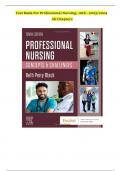Exam (elaborations)
Test Bank For Professional Nursing 10th Edition by Beth Black 9780323776653 Chapter 1-16 All Chapters | Complete Guide A+
Course
Professional Nursing-Concepts and Challenges, 10th
Institution
Professional Nursing-Concepts And Challenges, 10th
Test Bank For Professional Nursing 10th Edition by Beth Black 9780323776653 Chapter 1-16 All Chapters | Complete Guide A+Test Bank For Professional Nursing 10th Edition by Beth Black 9780323776653 Chapter 1-16 All Chapters | Complete Guide A+Test Bank For Professional Nursing 10th Edition by Beth...
[Show more]
Preview 4 out of 276 pages
Uploaded on
September 25, 2024
Number of pages
276
Written in
2024/2025
Type
Exam (elaborations)
Contains
Questions & answers
Institution
Professional Nursing-Concepts and Challenges, 10th
Course
Professional Nursing-Concepts and Challenges, 10th
$17.89
100% satisfaction guarantee
Immediately available after payment
Both online and in PDF
No strings attached
Test Bank For Professional Nursing, 10th - 2023/2024




